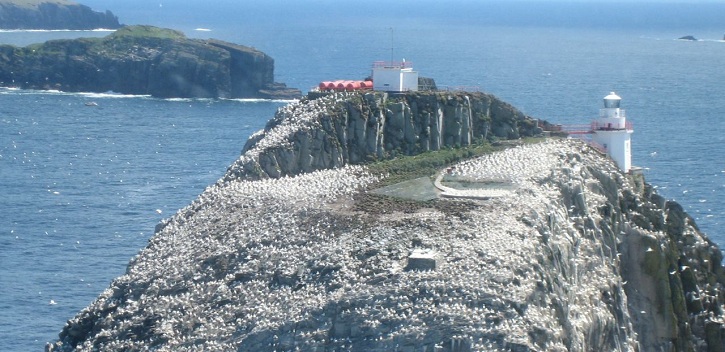2013 Press Releases
The courteous gannets…

Colonies of gannets maintain vast exclusive fishing ranges despite doing nothing to defend their territory from rival colonies according to research published in Science recently.
A team of researchers in the UK and Ireland observed that northern gannets, which can fly hundreds of kilometres on a single fishing trip, avoided visiting the fishing grounds of gannets from neighbouring colonies.
The findings could transform our understanding of animals’ foraging patterns because individual gannets do nothing to enforce this territory or communicate its boundaries when out at sea. A bird from a neighbouring colony would be free to fly and fish unhindered.
Dr Mark Jessopp of the Coastal & Marine Research Centre, University College Cork explains: “In other animals such as ants, feeding areas around colonies are aggressively defended. While gannets do defend nest sites on land, they don’t defend foraging territories out at sea. However, little overlap in foraging areas occurs, even between closely located colonies. This opens a new way of thinking about how territories develop”
Researchers from more than 14 institutions in the UK, Ireland and France tracked the flights of nearly 200 northern gannets flying from 12 colonies around the British Isles.
Rather than finding criss-crossing flight paths as the birds headed out from their colonies, they plotted a strictly segregated map. The most striking example was seen off the west coast of Ireland where gannets from two colonies, Bull Rock and Little Skellig, are within sight of each other yet head off in different directions.
The explanation has nothing to do with territorial behaviour, but instead seems to be a matter of mathematics reinforced by the culture of colonies.
Dr Jessopp says: “Food resources in the marine environment can be very short-lived. For example, predatory whales and dolphins may drive fish to the surface. Only the first gannets to arrive are likely to get the fish, since when gannets start plunging into the water to feed, the fish dive deeper to escape this new threat. It then becomes a game of numbers; there is a higher chance that individuals from closer colonies will arrive in the area first. Cultural transmission within the colonies then seems to reinforce this geographical calculus.”
Dr Thomas Bodey, postdoctoral researcher at the University of Exeter and joint lead of the study explains: “Gannets readily follow each other when at sea. Finding such separation between colonies, even when visible from each other, indicates that competition for food cannot be the only explanation and suggests cultural differences between colonies may be important. As with humans, birds have favoured routes to travel, and if new arrivals at a colony follow experienced old hands then these patterns can quickly become fixed, even if other opportunities potentially exist."
The northern gannet is Europe’s largest seabird, with a wingspan of around 2m, and nests on steep cliffs and rocky islands. Attaching the matchbox-sized satellite transmitters and GPS loggers used to track the birds was sometimes a major challenge. At the biggest mainland UK colony at Bempton Cliffs in East Yorkshire, an army abseiling team from Joint Services Mountain Training Wing was called in to help.
The UK supports between 60 -70 per cent of the world’s northern gannets and the discovery that colonies depend on particular sea areas has implications for the location of marine protected areas and offshore energy development.
The research also has wide ranging implications for our understanding of animal behaviour. Co-author Dr Keith Hamer, Reader in Animal Ecology in the University of Leeds’ Faculty of Biological Sciences says: “We knew that species like ants that forage over short distances show segregation, but now we find that segregation not only occurs in gannets too, but it is there just as strongly as in ants. That immediately opens the door to asking how many other species that we assumed would not show segregation actually do. There is no reason to believe that gannets are unique.
Professor Stuart Bearhop, Professor of Animal Ecology at the University of Exeter says: “We understand an awful lot about what these seabirds do on land, but until recently we knew shockingly little about what they do at sea. The technology is now allowing us to leave the coast with them and we are discovering more and more of these amazing and unexpected patterns.”
The research involved the Universities of Leeds, Exeter, Plymouth, Liverpool in the UK. In Ireland, University College Cork and Trinity College Dublin were involved. Other participating agencies included the Royal Society for the Protection of Birds, Centre for Ecology & Hydrology and the Centre National de la Recherche Scientifique, France.
The work was funded by the Beaufort Marine Research Award in Ireland and the UK Natural Environmental Research Council, the Department of Energy & Climate Change, the Centre for Ecology & Hydrology, the Centre National de la Recherche Scientifique, the Ligue pour la Protection des Oiseaux, the Alderney Commission for Renewable Energy, and the European Union.
